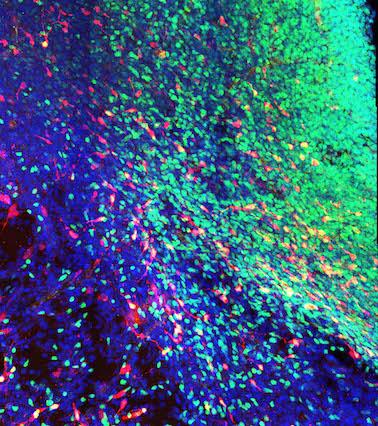Interneurons find their way to the striatum

MGE-derived interneurons are shown expressing EphB3 (red) and Nkx2-1 (green) migrating to the striatum. Credit: Verona Villar-Cerviño, PhD Instituto de Neurociencias (CSIC-UMH)
These results, published in Journal of Neuroscience in collaboration with investigators from the Instituto de Neurociencias in Alicante (Spain), also reveal the molecule nature of the cues regulating the migration of striatal interneurons.
During development, the medial ganglionic eminence (MGE), a transitory brain structure, produces several populations of GABAergic inhibitory neurons, including cortical and striatal interneurons.
While most research studies have focused on the migration of interneurons to the cortex, very little is known about the mechanisms through which interneurons colonise the striatum. Both cortical and striatal interneurons can be attracted by Nrg1 sources present in the cerebral cortex and the striatum.
Therefore, the segregation of these two populations of interneurons must depend on repulsive signals that prevent the colonization of regions outside their final target.
Experiments carried out by the group of Prof. Marín demonstrated that striatal interneurons are repelled by the cerebral cortex through a mechanism that involves Eph/ephrins signalling.
This new study also showed that responsiveness of MGE-derived striatal interneurons to attractive and repulsive cues is at least in part controlled by the postmitotic activity of the transcription factor Nkx2-1. These results reveal parallel mechanisms of target chemoattraction and off-target chemorepulsion for the migration of interneurons to the cortex and striatum.
###
This work was supported by grants from the Spanish Ministry of Economy SAF2011- 28845 and CONSOLIDER CSD2007-00023.
Original publication: Villar-Cerviño V., Kappeler C., Nóbrega-Pereira S., Henkemeyer M., Rago L., Nieto MA. & Marín O. (2015) Molecular Mechanisims Controlling the Migration of Striatal Interneurons. J Neurosci, in press.
For further information please contact Andreia Carvalho, Head of Scientific Affairs, MRC Centre for Developmental Neurobiology, King's College London (andreia.carvalho@kcl.ac.co.uk)
Media Contact
All latest news from the category: Life Sciences and Chemistry
Articles and reports from the Life Sciences and chemistry area deal with applied and basic research into modern biology, chemistry and human medicine.
Valuable information can be found on a range of life sciences fields including bacteriology, biochemistry, bionics, bioinformatics, biophysics, biotechnology, genetics, geobotany, human biology, marine biology, microbiology, molecular biology, cellular biology, zoology, bioinorganic chemistry, microchemistry and environmental chemistry.
Newest articles

A universal framework for spatial biology
SpatialData is a freely accessible tool to unify and integrate data from different omics technologies accounting for spatial information, which can provide holistic insights into health and disease. Biological processes…

How complex biological processes arise
A $20 million grant from the U.S. National Science Foundation (NSF) will support the establishment and operation of the National Synthesis Center for Emergence in the Molecular and Cellular Sciences (NCEMS) at…

Airborne single-photon lidar system achieves high-resolution 3D imaging
Compact, low-power system opens doors for photon-efficient drone and satellite-based environmental monitoring and mapping. Researchers have developed a compact and lightweight single-photon airborne lidar system that can acquire high-resolution 3D…





















